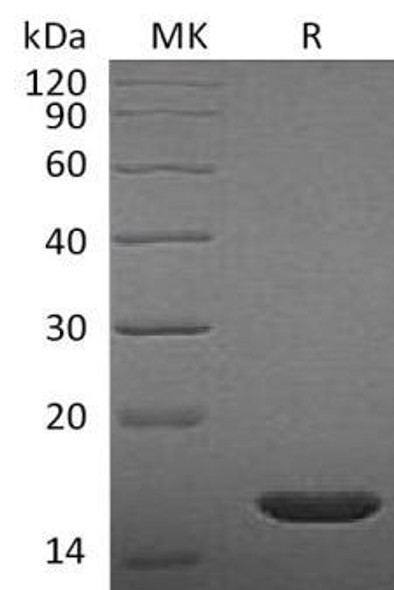Growth Factors & Cytokines Recombinant Proteins
Rat FGF 1 Recombinant Protein (RPPB0204)
- SKU:
- RPPB0204
- Product Type:
- Recombinant Protein
- Species:
- Rat
- Uniprot:
- P61149
- Research Area:
- Growth Factors & Cytokines
Description
| Product Name: | Rat FGF 1 Recombinant Protein |
| Product Code: | RPPB0204 |
| Size: | 50µg |
| Species: | Rat |
| Target: | FGF 1 |
| Synonyms: | Fibroblast growth factor 1, FGF-1, Acidic fibroblast growth factor, aFGF, binding growth factor 1, HBGF-1, Fgf1, Fgfa, HBGF1. |
| Source: | Escherichia Coli |
| Physical Appearance: | Sterile Filtered White lyophilized (freeze-dried) powder. |
| Formulation: | Lyophilized at a concentration of 1 mg/ml in 5mM Na2PO4, pH-7.5 and 50mM NaCl. |
| Solubility: | It is recommended to reconstitute the lyophilized Fibroblast Growth Factor-acidic in sterile 18M?-cm H2O not less than 100�g/ml, which can then be further diluted to other aqueous solutions. |
| Stability: | Lyophilized Fibroblast Growth Factor-1 although stable at room temperature for 3 weeks, should be stored desiccated below -18°C. Upon reconstitution FGF-a should be stored at 4°C between 2-7 days and for future use below -18°C.Please prevent freeze-thaw cycles. |
| Purity: | Greater than 98.0% as determined by SDS-PAGE. |
| Amino Acid Sequence: | MFNLPLGNYK KPKLLYCSNG GHFLRILPDG TVDGTRDRSD QHIQLQLSAE SAGEVYIKGT ETGQYLAMDT EGLLYGSQTP NEECLFLERL EENHYNTYTS KKHAEKNWFV GLKKNGSCKR GPRTHYGQKA ILFLPLPVSS D |
| Biological Activity: | The ED50 as determined by the dose-dependent proliferation of mouse BALB/c 3T3 cells, is less than 0.2ng/ml corresponding to a Specific Activity of 5x106IU/mg. |
Acidic fibroblast growth factor is a member of the fibroblast growth factor (FGF) family. FGF family members possess broad mitogenic and cell survival activities, and are involved in a variety of biological processes, including embryonic development, cell growth, morphogenesis, tissue repair, tumor growth and invasion. This protein functions as a modifier of endothelial cell migration and proliferation, as well as an angiogenic factor. It acts as a mitogen for a variety of mesoderm- and neuroectoderm-derived cells in vitro, thus is thought to be involved in organogenesis. Three alternatively spliced variants encoding different isoforms have been described. The binding growth factors are angiogenic agents in vivo and are potent mitogens for a variety of cell types in vitro. There are differences in the tissue distribution and concentration of these 2 growth factors.
Fibroblast Growth Factor-acidic�Rat Recombinant (FGF-1) produced in E.Coli is a single, non-glycosylated, polypeptide chain containing 141 amino acids and having a molecular mass of 15.9 kDa.The FGF acidic is purified by proprietary chromatographic techniques.
| UniProt Protein Function: | FGF1: Plays an important role in the regulation of cell survival, cell division, angiogenesis, cell differentiation and cell migration. Functions as potent mitogen in vitro. Monomer. Homodimer. Interacts with FGFR1, FGFR2, FGFR3 and FGFR4. Affinity between fibroblast growth factors (FGFs) and their receptors is increased by heparan sulfate glycosaminoglycans that function as coreceptors. Found in a complex with FGFBP1, FGF1 and FGF2. Interacts with FGFBP1. Part of a Cu(2+)-dependent multiprotein aggregate containing FGF1, S100A13 and SYT1. Interacts with SYT1. Interacts with S100A13. Belongs to the heparin-binding growth factors family. 2 isoforms of the human protein are produced by alternative splicing. |
| UniProt Protein Details: | Protein type:Motility/polarity/chemotaxis; Cytokine; Cell development/differentiation Cellular Component: nucleoplasm; extracellular space; proteinaceous extracellular matrix; cytoplasm; nucleolus; extracellular region; cytosol; nucleus Molecular Function:heparin binding; protein binding; growth factor activity; Hsp70 protein binding; receptor binding; fibroblast growth factor receptor binding Biological Process: fibroblast growth factor receptor signaling pathway; positive regulation of transcription, DNA-dependent; multicellular organismal development; positive regulation of cholesterol biosynthetic process; cardiac muscle cell proliferation; positive regulation of MAP kinase activity; cell proliferation; positive regulation of angiogenesis; positive regulation of cell division; induction of an organ; positive regulation of cell proliferation; positive regulation of transcription from RNA polymerase II promoter; positive regulation of protein amino acid phosphorylation; angiogenesis; cell differentiation; positive regulation of epithelial cell proliferation; lung development; positive regulation of cell migration |
| NCBI Summary: | may play a role in neurite outgrowth; may regulate cell differentiation in the nervous system; may act in synergy with fibronectin to enhance neuronal cell adhesion [RGD, Feb 2006] |
| UniProt Code: | P61149 |
| NCBI GenInfo Identifier: | 47117672 |
| NCBI Gene ID: | 25317 |
| NCBI Accession: | P61149.1 |
| UniProt Secondary Accession: | P61149,P10935, |
| UniProt Related Accession: | P61149 |
| Molecular Weight: | 17,418 Da |
| NCBI Full Name: | Fibroblast growth factor 1 |
| NCBI Synonym Full Names: | fibroblast growth factor 1 (acidic) |
| NCBI Official Symbol: | Fgf1�� |
| NCBI Official Synonym Symbols: | FGF-1; HBGF1; HBGF-1�� |
| NCBI Protein Information: | fibroblast growth factor 1; aFGF; acidic fibroblast growth factor; heparin-binding growth factor 1; Fibroblast growth factor 1 (heparin binding) |
| UniProt Protein Name: | Fibroblast growth factor 1 |
| UniProt Synonym Protein Names: | Acidic fibroblast growth factor; aFGF; Heparin-binding growth factor 1; HBGF-1 |
| Protein Family: | Fibroblast growth factor |
| UniProt Gene Name: | Fgf1�� |
| UniProt Entry Name: | FGF1_RAT |






